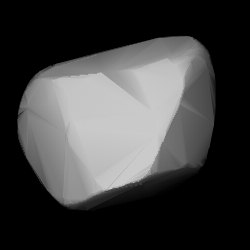2984 Chaucer, provisionally designated 1981 YD, is a main-belt asteroid, which was discovered by American astronomer Edward Bowell at Lowell's Anderson Mesa Station in Flagstaff, Arizona, on 30 December 1981.

42 Isis is a large main-belt asteroid, measuring 100.2 km in diameter with a stony (S-type) composition. It was discovered by English astronomer N.R. Pogson on 23 May 1856 at Oxford, and was his first asteroid discovery. The asteroid's name was chosen by Manuel John Johnson, director of the Radcliffe Observatory in Oxford. Although Isis is the name of an Egyptian goddess, the name was chosen in homage to Pogson's astronomer daughter, (Elizabeth) Isis Pogson. In addition, the Isis is the stretch of the River Thames that runs through Oxford.

55 Pandora is a fairly large and very bright asteroid in the asteroid belt. Pandora was discovered by American astronomer and Catholic priest George Mary Searle on September 10, 1858, from the Dudley Observatory near Albany, NY. It was his first and only asteroid discovery.
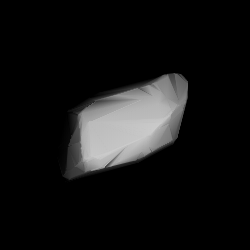
244 Sita is a background asteroid from the inner region of the asteroid belt, approximately 11 kilometers in diameter. It was discovered on 14 October 1884, by an Austrian astronomer Johann Palisa in the Vienna Observatory. It was named for the Hindu deity Sita.
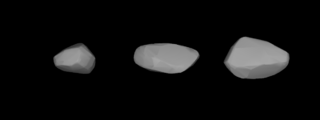
265 Anna is a typical Main belt asteroid.

266 Aline is a fairly large main belt asteroid that was discovered by Johann Palisa on 17 May 1887 in Vienna and is thought to have been named after the daughter of astronomer Edmund Weiss. It is a dark C-type asteroid and is probably composed of primitive carbonaceous material. 266 Aline is orbiting close to a 5:2 mean motion resonance with Jupiter, which is located at 2.824 AU.

267 Tirza is a fairly sizeable, very dark Main belt asteroid.

274 Philagoria is a typical Main belt asteroid.

289 Nenetta is an A-type asteroid with a diameter of 38 km. It was discovered by Auguste Charlois on 10 March 1890 in Nice, France. The asteroid is orbiting the Sun at a distance of 2.87 AU with an eccentricity (ovalness) of 0.204 and an orbital period of 4.87 yr. The orbital plane is inclined at an angle of 6.7° to the plane of the ecliptic.

349 Dembowska is a large asteroid of the main belt, discovered on 9 December 1892, by the French astronomer Auguste Charlois while working at the observatory in Nice, France. It is named in honor of the Baron Hercules Dembowski, an Italian astronomer who made significant contributions to research on double and multiple stars.
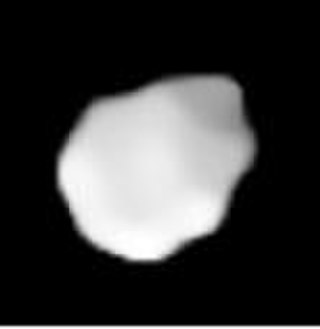
354 Eleonora is a large, stony main-belt asteroid that was discovered by the French astronomer Auguste Charlois on January 17, 1893, in Nice.
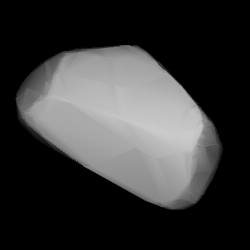
497 Iva is a main-belt asteroid orbiting the Sun, not to be confused with 1627 Ivar. It was discovered by American astronomer R. S. Dugan on 4 November 1902, and was named for Iva Shores, the young daughter of the family where he was staying in Heidelberg. This object is orbiting at a distance of 2.85 AU with a period of 4.82 yr and an eccentricity of 0.3. The orbital plane is inclined at an angle of 4.8° to the plane of the ecliptic.
500 Selinur is a minor planet, specifically an asteroid orbiting in the asteroid belt. Like 501 Urhixidur and 502 Sigune, it is named after a character in Friedrich Theodor Vischer's then-bestseller satirical novel Auch Einer.

502 Sigune is a minor planet, specifically an asteroid orbiting primarily in the asteroid belt. Like 501 Urhixidur and 500 Selinur, it is named after a character in Friedrich Theodor Vischer's then-bestseller satirical novel Auch Einer.
633 Zelima is a minor planet orbiting the Sun in the asteroid belt with a magnitude of 10.7. The name may have been inspired by the asteroid's provisional designation 1907 ZM.
798 Ruth is a minor planet orbiting the Sun that was discovered by the German astronomer Max Wolf on 21 November 1914. It may have been named after the biblical character Ruth. This main belt asteroid has an orbital period of 5.23 years and is orbiting at a distance of 3.0 AU from the Sun with an eccentricity (ovalness) of 0.036. The orbital plane is tilted by 9.2° from the plane of the ecliptic.
805 Hormuthia is a minor planet orbiting the Sun. This asteroid follows an elliptical orbit through the main asteroid belt that reaches perihelion just outside the Kirkwood gap at 2.5 AU. Its estimated diameter is 73 km, and it is one of the 500 largest asteroids. 805 Hormuthia was discovered by Max Wolf in 1915, at the University of Heidelberg. The planet is named after Hormuth Kopff, the wife of astronomer August Kopff.
999 Zachia is a main-belt asteroid that was discovered by German astronomer Karl W. Reinmuth in 1923 and named after Hungarian astronomer Franz Xaver von Zach.
19738 Calinger (provisional designation 2000 AS97) is a background asteroid from the inner regions of the asteroid belt, approximately 3 kilometers in diameter.
30000 Camenzind (provisional designation 2000 AB138) is a very bright background asteroid from the inner region of the asteroid belt, approximately 2.6 kilometers (1.6 miles) in diameter. It was discovered on 4 January 2000, by astronomers of the Lincoln Near-Earth Asteroid Research program conducted at the Lincoln Laboratory's Experimental Test Site near Socorro, New Mexico, in the United States. The asteroid was named for 2014-ISTS awardee Kathy Camenzind.
